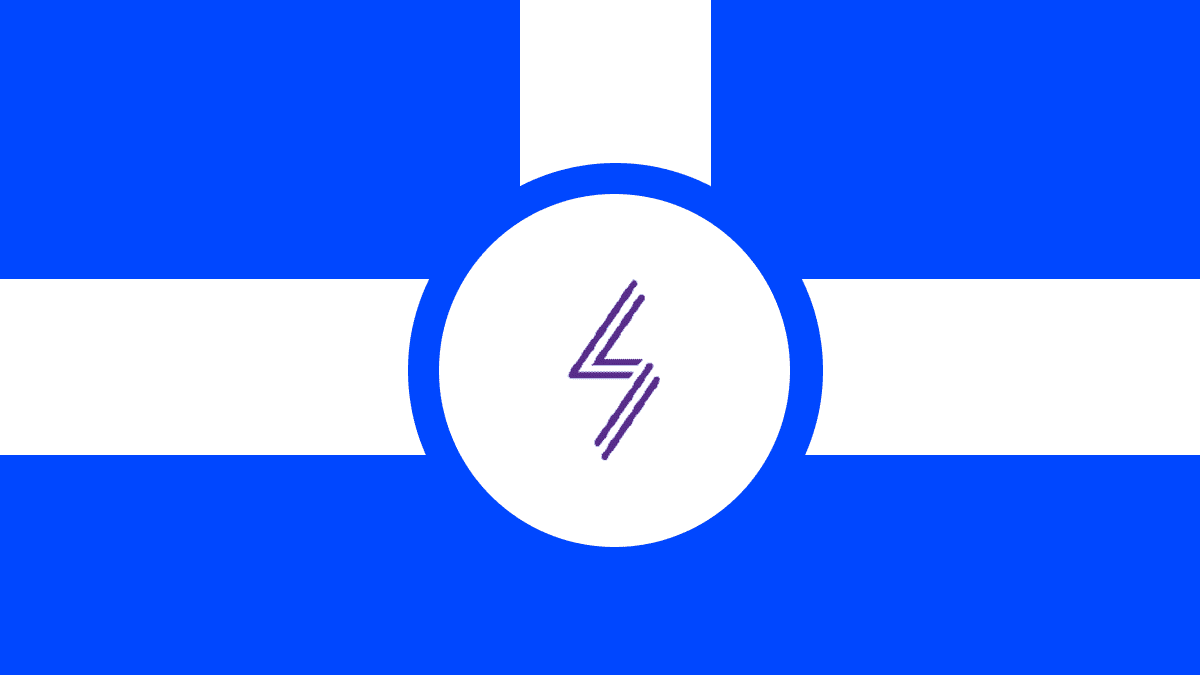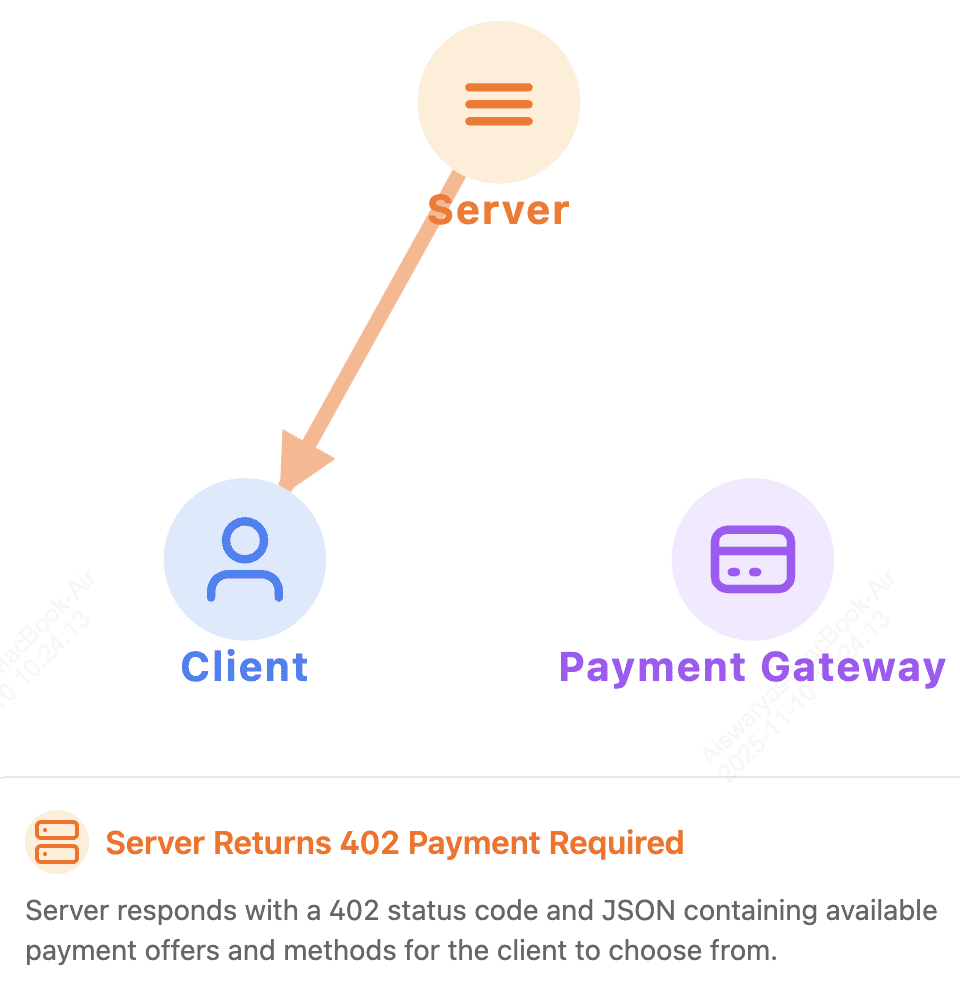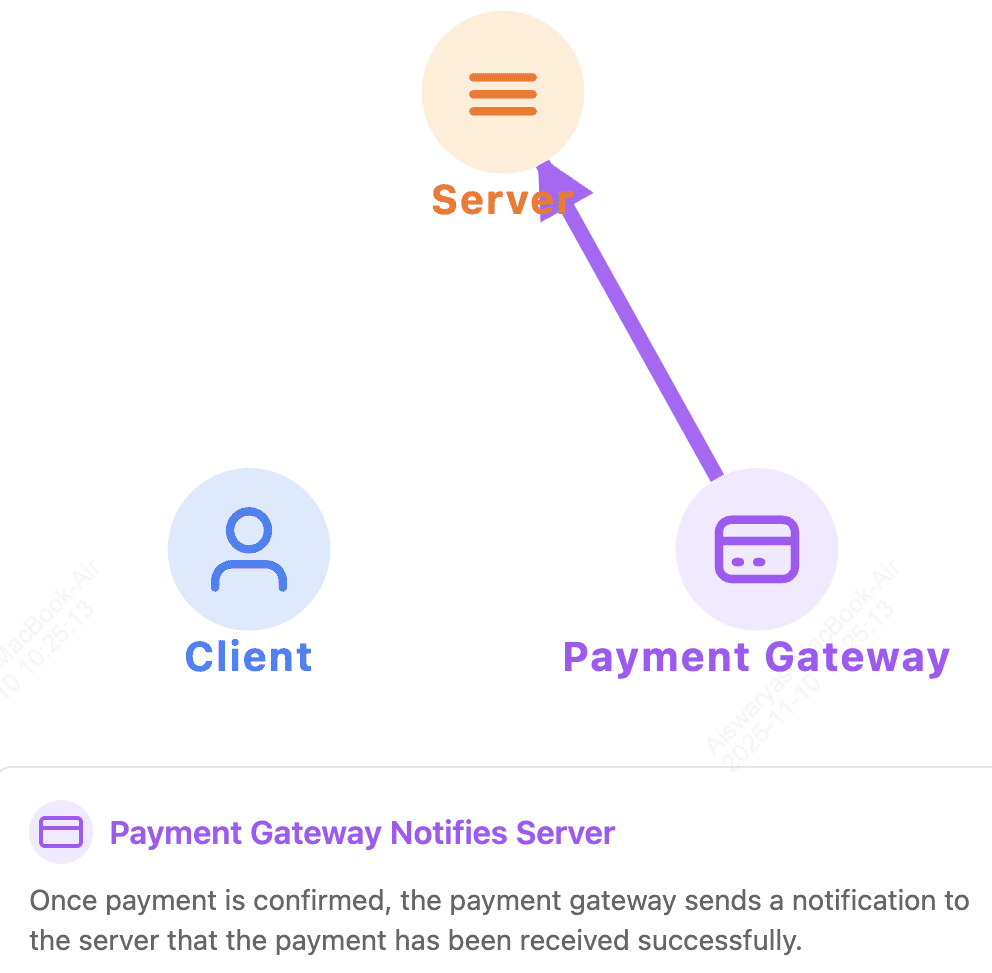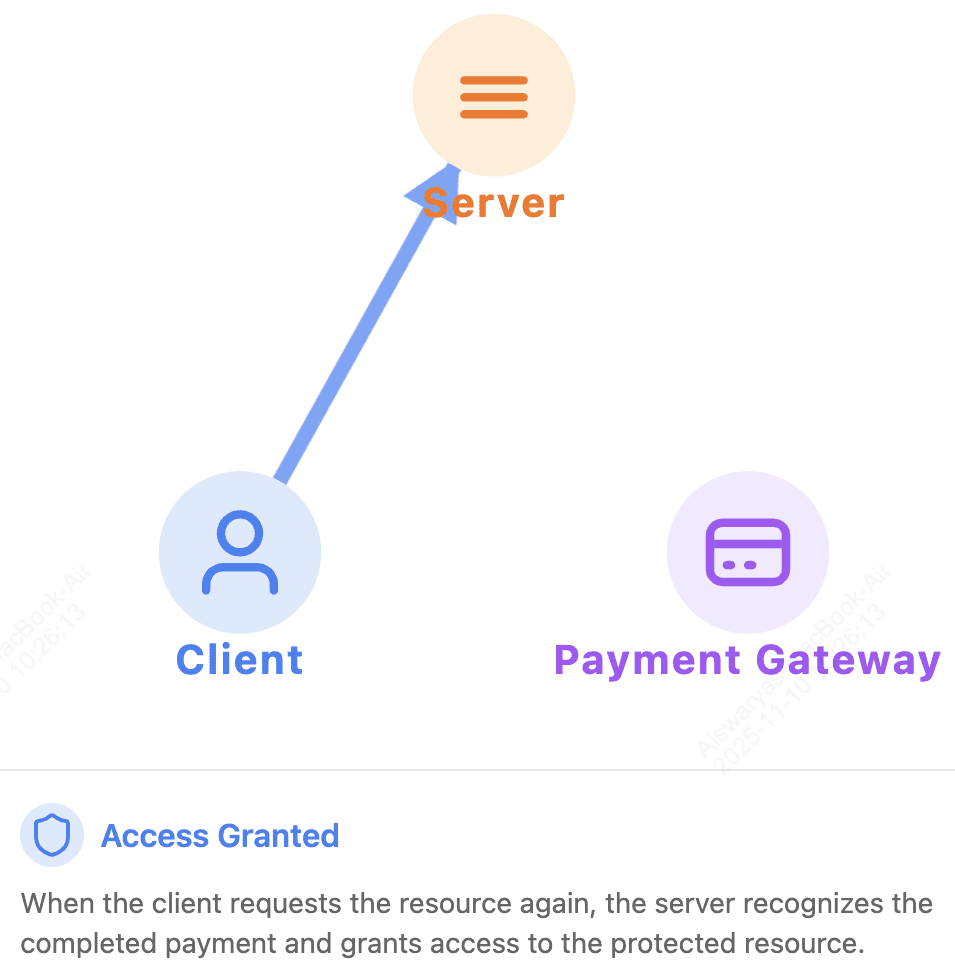L402 is a machine-native payment protocol that turns the
Lightning Network into a global “pay-per-request” system for the internet. In 2025, Cloudflare began processing over 1 billion HTTP 402 responses per day, Lightning usage surged past 100 million estimated wallet users, and
AI agents started consuming more paid APIs than human users.
Traditional billing models, such as credit cards, cookies, subscriptions, can’t keep up with automated software and microtransactions. L402 solves that by making the payment itself the authentication, eliminating accounts, logins, and API keys entirely. Built on the long-dormant HTTP 402 “Payment Required” standard, it finally delivers what the early web envisioned: machines paying for digital resources on demand.
This guide explores how L402 brings the HTTP 402 “Payment Required” standard to life, using the Lightning Network to let AI agents pay automatically for APIs, data, and compute, creating true machine-to-machine commerce.
What Is L402 Payment Protocol for AI Agents on Lightning Network?
L402 is a simple, machine-friendly payment protocol that lets a browser, app, or AI agent pay for online resources, like APIs, datasets, or premium content, in one automated step. When a client requests something that isn’t free, the server replies with an HTTP “402 Payment Required” message containing the price and payment instructions. The client then pays, typically using the
Bitcoin Lightning Network for fast, low-cost microtransactions.
Once the payment is confirmed, the client retries the request with proof of payment and instantly receives access, with no accounts, passwords, API keys, or human involvement. The payment itself acts as the authentication, which makes the process lightweight, global, and secure.
This matters because the internet’s payment system was built for humans clicking “Pay Now” buttons, not AI. As AI agents and automated apps consume more data, compute, and content, L402 gives them a way to pay, authenticate, and operate autonomously, enabling true machine-to-machine commerce.
At the same time, Lightning usage has exploded, with 100M+ estimated wallet users and routing nodes settling hundreds of millions of micro-payments every month. AI frameworks like LangChain, CrewAI, and OpenAI plugins are already testing payment-native agents that can buy data and compute on demand. The shift is clear: before L402, machines consumed content for free, and now, they can pay automatically, fairly, and globally.
Why Does L402 Use Lightning Network?
The Lightning Network is perfect for tiny, automated payments because it’s fast, inexpensive, and works anywhere in the world. A Lightning payment typically confirms in under a second and costs a fraction of a cent, something traditional card networks or bank transfers can’t do. This makes it practical to charge $0.01 or even $0.0001 for a single API call, AI inference, or data request.
Even more importantly, Lightning is programmable. Apps, smart devices, and AI agents can send payments automatically, without humans typing passwords or clicking checkout buttons. Instead of people paying websites, machines can pay machines, unlocking a new economy where software buys data, compute, or content on demand.
L402 in Action: Aperture Proxy
Aperture is a tool built by Lightning Labs that makes L402 easy to use in real applications. It sits in front of an API and automatically handles everything: creating Lightning invoices, verifying payment, issuing Macaroons, and forwarding valid requests to the real server.
For developers, this means they don’t need to redesign their system or build a billing system from scratch. By adding Aperture, any normal HTTP API can start charging per request, per megabyte, or even per minute of GPU compute. In many cases, it takes just a few minutes to turn a free API into a pay-per-use business.
How Does L402 Protocol Work?
Imagine an AI agent or app wants paid data, like weather updates,
crypto prices, or a premium AI service.
Step 1: The client asks for data
The browser, app, or AI agent sends a request like GET /premium-data to access a paid resource.
Step 2: The server says “Payment Required”
Instead of sending the data, the server responds with HTTP 402 Payment Required, showing the price and a Lightning invoice the client can pay.
Step 3: The client pays
The client pays the invoice over the Lightning Network, which usually confirms in under a second.
Step 4: The client gets proof of payment
Once paid, the client receives a preimage (cryptographic proof of payment) and a Macaroon (an access token).
Step 5: The client tries again, now with proof
The request is sent again, this time with the payment proof in the header: GET /premium-data + payment-header.
Step 6: The server verifies and unlocks the data
The server checks that payment is valid, then returns 200 OK and the premium data.
In short, L402 payments require no accounts, no passwords, no API keys, just pay and get access.
Real-World Example of How L402 Payments Work
Think of a website that sells premium data for $0.01 per request; for example, live weather or crypto prices.
1. A chatbot asks for the data.
2. The server replies, “You need to pay first,” and sends a Lightning invoice.
3. The chatbot pays $0.01 in Bitcoin over the Lightning Network.
4. The payment confirms almost instantly, usually within a second.
5. The chatbot asks again, this time including the proof of payment.
6. The server checks it and sends the data back.
This is not theory; developers can already build this today using Lightning Labs’ free, open-source tools.
What Are L402 Macaroons on Lightning and How Do They Work?
Macaroons are digital tokens that act like secure access passes. You can think of them as cookies with extra cryptographic locks: they prove you paid for something, and the server can verify them without needing usernames, passwords, or a big user database.
When you pay a Lightning invoice, you receive a preimage that “unlocks” your Macaroon. That unlock lets you access a paid API, but only within the limits set by the provider, such as a time window or number of requests. This means no accounts, no passwords, and no API keys to leak, just pay and use the service.
What Can AI Agents Pay For: Key Use Cases of L402
L402 enables a new economy where bots pay bots:
1. Pay-per-API: APIs that provide live data, like crypto prices, weather, maps, or legal information, can charge a tiny fee each time they’re used. Instead of paying monthly subscriptions, apps and AI agents can pay a few cents (or less) only when they request data.
2. Pay-per-Content: Websites can charge small payments per article, research paper, or premium analysis, instead of locking everything behind long subscriptions. AI crawlers, chatbots, and users simply pay per item and unlock the content instantly.
3. Compute and AI: Developers can sell access to GPU power, AI model training, translation, or transcription as pay-per-use services. Instead of paying for a whole server, clients pay only for the exact processing time or resources they consume.
4. IoT and Smart Devices: Smart devices can automatically pay each other for power, bandwidth, or sensor data, for example, cars paying roadside sensors or drones paying for updated maps. This enables machine-to-machine commerce without humans needing to manage every transaction.
If data or compute is scarce, L402 lets machines buy it.
Key Benefits of L402 Lightning Payments for Developers and Businesses
L402 gives companies and developers a simple way to earn from their APIs, data, and digital content without forcing users to sign up or subscribe. Instead of losing revenue to bots, ad blockers, and AI scrapers, businesses can switch to pay-per-access and get paid automatically.
• No user accounts needed: The payment itself acts as authentication, so there’s no signup, password storage, or account recovery to manage.
• True micro-payments: Lightning makes it profitable to charge a fraction of a cent per API call or per piece of content, something credit cards can’t do efficiently.
• Global by default: Anyone in the world with a Lightning wallet can pay instantly, without banks, currency issues, or regional restrictions.
• Instant settlement: Businesses get paid in seconds, not days or weeks, and never deal with chargebacks or failed card payments.
• Easy integration: Developers can add L402 to existing APIs with only a small amount of middleware, no need to redesign billing systems.
• Machine-friendly: AI agents and automated apps can pay and operate on their own, enabling machine-to-machine commerce and new business models.
L402 vs. Traditional Web Payments: Key Differences
Traditional web payments were built for humans: you enter card details, click checkout, wait for approval, and the website unlocks content. This model doesn’t work for AI agents or automated apps, and it definitely doesn’t support micro-transactions; credit card fees alone are often higher than the cost of the data being purchased. It also requires accounts, passwords, chargeback protections, subscription billing systems, and regional banking support, which makes global access complicated and expensive.
L402 removes all of that. The payment itself becomes the authorization, so there are no accounts, no credit cards, no API keys, just pay and go. Lightning Network payments confirm in under a second, cost fractions of a cent, and work worldwide. For AI workloads, where thousands of tiny requests happen every minute, L402 is dramatically simpler, cheaper, and built for automation from the start.
L402 vs x402: What’s the Difference?
L402 and
x402 both enable pay-per-request payments on the web, but they come from different ecosystems and work in different ways. L402 is built by Lightning Labs and uses the Bitcoin Lightning Network + Macaroons to authenticate paid API calls with instant, low-fee microtransactions.
In contrast, x402 was introduced by Coinbase and Cloudflare, and typically uses
USDC and EVM chains like
Base or
Arbitrum to settle payments through standard smart-contract rails. Put simply: L402 is Lightning-native and Bitcoin-centric, while x402, such as
PayAI Network, is
stablecoin-centric and EVM-native. Both aim to monetize digital resources automatically, but they use different tools, ecosystems, and payment rails to get there.
What Are the Challenges and Limitations of L402 Payments on Lightning?
Before adopting L402, it’s important to understand the technical and operational challenges that come with Lightning-based machine payments.
1. Lightning infrastructure has to stay online and funded, which adds operational responsibility for developers.
2. Some enterprises still prefer traditional fiat billing and may not be ready to accept Bitcoin or Lightning payments.
3. AI agents need wallets and basic key management, which introduces new security and setup steps.
4. Legal, tax, and accounting rules for machine-to-machine payments are still developing and may vary by region.
5. Revoking or updating Macaroons requires careful key rotation to prevent unauthorized access.
Final Thoughts
L402 finally brings the old HTTP 402 Payment Required concept to life, enabling automatic payments for APIs, content, and compute without accounts or manual checkout. It gives developers a simple way to monetize digital resources, lets publishers charge AI crawlers fairly, and allows AI agents to pay for data on their own. For services that run thousands of tiny requests per day, pay-per-use becomes practical instead of relying solely on subscriptions or ads.
That said, the ecosystem is still young. Tooling, standards, and best practices continue to evolve, and businesses should test carefully before relying on L402 for critical workloads. The opportunity is significant, but like any emerging technology, it comes with technical and operational risks that users should evaluate before adopting.
Related Reading













